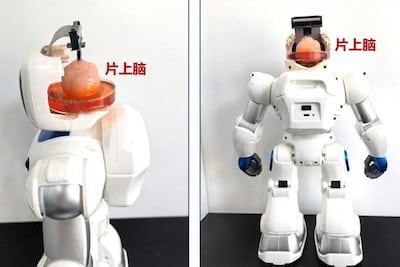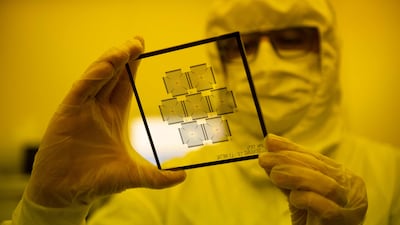The media talks perhaps too often about science fiction becoming scientific fact, but such discussion may be justified when it comes to recent work in China.
Researchers at Tianjin University created a robot – compared in one report to Frankenstein’s monster – that had a brain-like control centre made from a clump of nerve cells or neurons cultured in a laboratory.
This ambitious fusion of electronics and biology is one of the latest inventions in the brave new world of biocomputing.
According to a recent report by the UK-based Nuffield Council on Bioethics, technologists are increasingly looking to develop devices where organoids – tiny, lab-grown organs – are connected to sensors and output mechanisms and that, like the Tianjin robot, respond to electrical stimulation and carry out tasks.

Artificial brains in laptops?
The field of biocomputing involves much more than sci-fi robots, as clusters of neurons may have the potential to be used within computers of the kind that most of us have.
Brain organoids –tiny brain-like bundles of neurons – are typically generated from stem cells, just as tiny kidney or lung organoids have been for many years, often because they are useful research tools.
According to Dr Michael Barros, a lecturer in AI and engineering in medicine at the University of Essex in the UK, it is "absolutely" possible that even consumer electronics could in future have real neurological material embedded within them.
"It comes with a bit of a challenge because we now have to make living organisms survive alone or by themselves or have the necessary environment to do their job," he said.

"You need to keep cells alive and have a specific infrastructure for that and we have companies that are thinking about this problem."
The cells could be contained within a structure that provides them with a stable environment and protects them from the conditions of the outer environment, which may alter.
Biological material does not live for ever, so another consideration would be ensuring that the limited lifespan of the cells did not render useless the device that they were part of.
"The best estimate is that these biocomputers can live up to 200 days, so you can ... plan to replace biocomputing units every so often. That will be part of the cost of operating this sort of infrastructure," Dr Barros said.
"In our lab we’re also interested in reliability. If we’re operating with a biological system, it tends to change over time. How can we ensure that doesn’t happen or that if it does happen, it doesn’t affect the computing task?"
Replacing the trusty computer chip
A key question is why manufacturers might want to use biological material within their computers. Why not just perfect the standard silicon-chip-based device?
Andrew Jackson, a professor neural interfaces at Newcastle University in the UK, said that the answer lay in efficiency.
"In what ways are our brains better than artificial neural networks?" he said. "One of the things that our brains are very good at is performing computations, but doing it in a very power-efficient way compared to the power required to run computer-based AI systems.
" … Presumably our brains have evolved over millions of years to be very efficient information processors. One potentially interesting thing is whether we could devise artificial intelligence systems that are much more power-efficient if we leverage the principles of biology and neuroscience."
Not all researchers are convinced that brain organoids could eventually find their way into routine use in consumer electronics.
Instead, an alternative role for them may be in helping people to better understand how actual brains work, as this could lead to the creation of more efficient computers that mimic the properties of biological material.
"I would say that creating an architecture that’s more brain-like is the more likely outcome than something that mixes a cell culture and a computer," said Prof Thomas Hartung, of the Centre for Alternatives to Animal Testing at the John Hopkins Bloomberg School of Public Health in the United States.
Most of the activities with brain organoids that Prof Hartung is involved with are, he said, "virtual experiments" in which the organoid may be playing a computer game.
One possible scenario that could be seen over time is that brain organoids, potentially trained using artificial intelligence, become used within supercomputers.
This could cut the electricity demands of today’s large-scale devices, which consume vastly more energy for a given level of computing power than the human brain.
Advancing healthcare
Separate to biocomputing, brain organoids could prove useful for understanding neurodevelopmental conditions, such as autism, or neurodegenerative diseases such as Parkinson’s.
As brain organoids become more complex, ethical issues may become more prominent, although some may consider these to be dwarfed in importance by concerns over the use in laboratory experiments of more than 115 million live animals each year, according to the Humane Society International.
Prof Hartung said that brain organoid technology was "very far away" from creating a system with properties such as self-awareness or the ability to experience suffering.
In his work the brain organoids are less than half a millimetres in diameter and have fewer neurological cells than a housefly. Typically, they may consist of tens of thousands of neurons, while a human brain has tens of billions.
Nevertheless, he said that ethicists visit his facility to discuss the work and he said that it was important to consider formulating an ethical framework around what takes place while the technology is at an early stage.
"We’re having these discussions now [so] we’re coming to something where we should say there should be a limit," he said.
Prof Søren Holm, who researches bioethical issues at the University of Manchester in the UK and the University of Oslo in Norway, said that current neural technologies were not "anywhere near" the point at which organoids could develop sentience – the ability to feel things positively or negatively – or consciousness, which would enable them to not just feel pain, but understand what they were feeling.
"They’re simply not large enough or complex enough," said Prof Holm, who is a former editor-in-chief of the Journal of Medical Ethics.
"They’re order of magnitude smaller than the simplest mammalian brain. We don’t have any reason to believe the organoids we create now would have anything like sentience or consciousness."
A key technical hurdle, he said, is that organoids do not have a blood supply, which significantly limits their size and, therefore, their capabilities.
Even if they could grow to a level of complexity in which they were sentient or conscious, he said it would be "in a quite different way" to the consciousness that we experience.
"Sentience and consciousness in organoids is a very interesting question, but with what we can do with organoids now, it is not something that, for instance, a regulator needs to think about, because it’s not [for] the near future," he said.
"I would take a fairly large bet we’re not going to see sentience or consciousness in organoids for the next 20 years."


